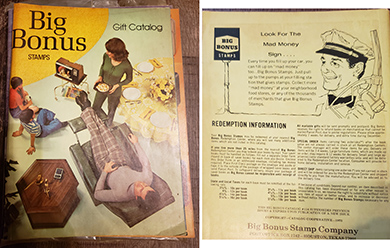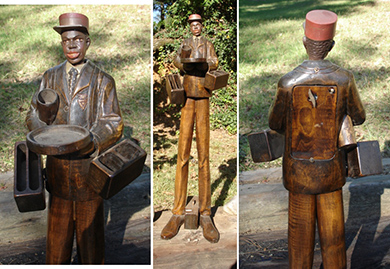 |
|
|||
 |
 |
|||
RINKER ON COLLECTIBLES — Column #1749 Copyright © Harry Rinker, LLC 2020 Questions
and Answers
QUESTION: I have a 1973, No. 114 Big Bonus Stamps Gift Catalog. What can you tell me about it? – TB, Conroe, TX, Email Question 
ANSWER: Trading stamps, small paper stamps given to customers by merchants, were a marketing method to build customer loyalty. The stamps have a minimal cash value. When pasted in saving books, the filled books can be redeemed for premiums ranging from appliances and furniture to personal items and toys. Schuster’s Department store, located in Milwaukee, Wisconsin, is credited with issuing the first merchant trading stamps in 1881. Other stores copied the trading stamp promotional concept. Sperry and Hutchinson Company (S&H Green Stamps) began in 1896. The use of merchant trading stamps spread from department stores to gasoline stations to grocery stores to drug stores and eventually throughout the mercantile community. Hundreds of local companies were formed and competed actively with national companies such as Blue Chips Stamps, Gold Bond Stamps, Plaid Stamps, and Top Value Stamps. The Golden Age of merchant trading stamps is the late 1940s through the 1970s. You own a merchant stamp redemption catalog from the Big Bonus Stamp Company, headquarters in Houston, Texas. The Big Bonus Stamp Company issued its first merchant stamp redemption catalog (Number 101) in 1960. [Author’s Aside #1: Over the years, I assembled a major collection of merchant stamp redemption catalogs. I have two Big Bonus Stamp Company catalogs – No. 101 and No. 104 – in my collection. The cover of Catalog 104 (1963) pictures 1962-1963 Mrs. America Lila Masson from Detroit, Michigan and 1963-1964 Mrs. America Mrs. Marilyn Mitchell from San Diego, California.] Like most purveyors of merchant trading stamps, the Big Bonus Stamp Company issued a new merchant stamp redemption catalog each year. In addition, the Big Bonus Stamp Company also opened store-front redemption centers in the greater Houston geographic region. The August 2, 1961, issue of “The Baytown Sun” (Baytown, Texas) ran a story entitled “Bonus Stamp Center Opens Thursday.” The Big Bonus Stamp Redemption Center was located at 800 West Texas Avenue, having moved from its previous location at 118 South Main Street. The article noted that premiums included items manufactured by Corning Ware, General Electric, Presto, R.C.A. Victor, Sessions, Sunbeam, Waring, and Westinghouse. The advertisement for Big Bonus Stamps on the back of your catalog notes: “Look for The / Mad Money / Sign / Every time you fill up your car, you can fill up on ‘mad money’ too…Big Bonus Stamps. Just pull up to the pumps at your filling station that gives stamps. Collect more ‘mad money’ at your neighborhood food stores, or any of the thousands of merchants that give Big Bonus Stamps.” In my research, I also found a discussion about a Coleman No. 425E704 stove, still in its Big Bonus Stamps shipping carton. It was redeemed for filled books of Big Bonus Stamps saving books in 1972. Chances are this stove wound up in the collection of a Coleman collector, one who would be willing to pay a premium price for the Big Bonus Stamps catalog that included the stove. This demonstrates the role the crossover collector plays in determining value for merchant stamp redemption catalogs. Crossover collectors often will pay double or more than a merchant stamp redemption catalog collector. A fair secondary market retail value to a merchant trading stamp collector for your 1973, No. 114 Big Bonus Stamps merchant stamp redemption catalog is between $12.50 and $15.00. The price will double if a “must-have-it” crossover collectors becomes involved. [Author’s Aside #2: The actual merchant stamps, the saver books into which the stamps were pasted, and filled or partially filled books have little to no value. The exceptions are Gold Bond and S&H filled books. The internet contains websites providing information on how to redeem filled saver books from these two brands.] IF THERE IS ONE, THERE IS ANOTHER: READERS' RESPONSES In “Rinker on Collectibles” Column 1745, I wrote about a 36-inch high, painted, wooden statue of an African-American man that had been purchased at auction in the 1970s. The bell-hop like figure’s head moved back and forth when a music box in his back played “Camptown Races.” Since writing the column, it appeared in several trade papers. On Sunday, July 12, I received an email from Eddy Campbell who lives in Fayette, Alabama. It read: “I have one of the hand carved Black man sculptures about which you wrote. I have had it for ten years or more. I bought it locally not knowing anything about it and have not been able to find out anything about it since. I was told it may have come from the New Orleans area and probably dates to the 1950s.” I immediately emailed Eddy asking him to send pictures. I wanted to compare the two statues. Eddy responded almost immediately. The two pieces were identical. His email with the images added to his story. “I bought this…from a friend. He called me one night and wanted me to come over. He needed some money. I bought the Black man statue for $450.00, not knowing what it was worth. But, I think it is probably worth twice or three times to the right person. My friend purchased it at auction in Mississippi in the 1990s. The music box is by Reuge.” 
A July 18 email from Bill Petrochuk, editor of the Coin Op Collectors Association website solved the mystery of the origin of the statue. Bill noted: “While the example in the article may be an original, it is most likely a reproduction made for Mike Gorski in the 1970s and 1980s. It was made using an automated carving machine. I knew Mike well. He had quite a few of them made, both with and without music boxes. Mike was well-known for his many reproductions of coin operated machines and artwork. He had a knack for finding craftsmen that could make the components for his creations. Mike never called them reproductions. He always referred to them as “replicas” and claimed they were better than the originals.” Mike Gorski (1931-2017), mentor, collector, dealer, and replicator, was inducted into the Coin-Op Collectors Association Hall of Fame in 2018. Mike was a character, a member of an elite group of memorable individuals in the antiques and collectibles trade. Unless a person was active within the coin-op community, Mike was unknown, as he was to the vast majority of members in the trade. As a tribute to Mike and a desire on my part that he not be forgotten, I am sharing his biography that appears on the Coin-op Collectors Association (COCA) Hall of Fame site with my readers: “Mike was known as the ‘Godfather of Coin-Op,’ and many called him ‘Uncle Mike.’ He was awarded the first ‘COCA Lifetime Achievement Award’ shortly before his death. “His quest for old slot machines would lead him to a lifetime spent finding, restoring, collecting and replicating coin-op machines and other ‘great stuff.’ He made his living as a Captain of a Fire Department and a landscaper. He also sold machines from his home in Ohio and at the Chicagoland shows. “Mike was known for his sense of humor and shenanigans. He loved to wheel and deal. His home was always open, and collectors from across America would stop to visit or phone Mike on a regular basis. If someone was looking for a part, a machine or a bit of knowledge, they could usually find it from Mike. “He collected all types of Gambling machines, Penny Arcade, Vending, and Mechanical Music. Many of us got the coin-op ‘bug’ after a visit with Mike. His memory continues to be an inspiration to us all.” The Coin-op community, like so many sub-collecting categories, was and is blessed to have a host of characters associated with it. Mike followed in the tradition of Richard “Dick” Bueschel, another great coin-op collector and researcher that is fondly remembered by older generation collectors who knew him. Hopefully, Mike and Dick have met in the great beyond and will share coin-op memories for eternity. Harry L. Rinker welcomes questions from readers about
collectibles, those mass-produced items from the twentieth and twenty-first centuries.
Selected letters will be answered in this column.
Harry cannot provide personal answers.
Photos and other material submitted cannot be
returned.
Send your questions to: Rinker on Collectibles, 5955 Mill
Point Court SE, Kentwood, MI 49512.
You also can e-mail your questions to
harrylrinker@aol.com.
Only e-mails containing a full name and mailing address
will be considered.
|
||||